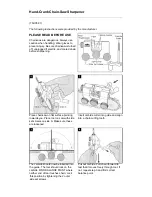
Tire Safety - Everything Rides On It
The National Traffic Safety Administration (NHTSA) has published a brochure (DOT HS 809 361) that discusses
all aspects of Tire Safety, as required by CFR 575.6. This brochure is reproduced in part below. It can be obtained
and downloaded from NHTSA, free of charge, from the following web site:
http://www.nhtsa.dot.gov/cars/rules/TireSafety/ridesonit/tires_index.html
Studies of tire safety show that maintaining proper tire pressure, observing tire and vehicle load limits (not carrying
more weight in your vehicle than your tires or vehicle can safely handle), avoiding road hazards, and inspecting tires
for cuts, slashes, and other irregularities are the most important things you can do to avoid tire failure, such as tread
separation or blowout and flat tires. These actions, along with other care and maintenance activities, can also:
Improve vehicle handling
Help protect you and others from avoidable breakdowns and accidents
Improve fuel economy
Increase the life of your tires.
This booklet presents a comprehensive overview of tire safety, including information on the following topics:
Basic tire maintenance
Uniform Tire Quality Grading System
Fundamental characteristics of tires
Tire safety tips
.
Use this information to make tire safety a regular part of your vehicle maintenance routine. Recognize that the time
you spend is minimal compared with the inconvenience and safety consequences of a flat tire or other tire failure.
Safety First–Basic Tire Maintenance
Properly maintained tires improve the steering, stopping, traction, and load-carrying capability of your vehicle.
Underinflated tires and overloaded vehicles are a major cause of tire failure. Therefore, as mentioned above, to
avoid flat tires and other types of tire failure, you should maintain proper tire pressure, observe tire and vehicle load
limits, avoid road hazards, and regularly inspect your tires.
Finding Your Vehicle's Recommended Tire Pressure and Load Limits
Tire information placards and vehicle certification labels contain information on tires and load limits. These labels
indicate the vehicle manufacturer's information including:
1.
Recommended tire size
2.
Recommended tire inflation pressure
3.
Vehicle capacity weight (VCW–the maximum occupant and cargo weight a vehicle is designed to carry)
4.
Front and rear gross axle weight ratings (GAWR– the maximum weight the axle systems are designed to
carry).
Both placards and certification labels are permanently attached to the trailer near the left front.
Gravity Tender V1.0
20
















































